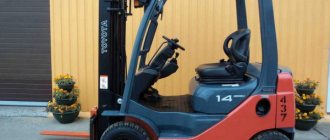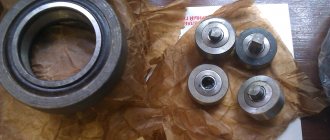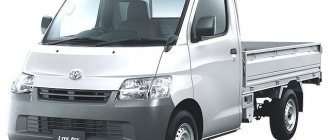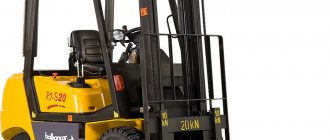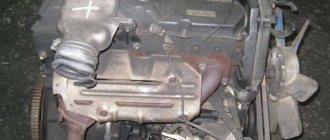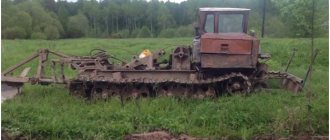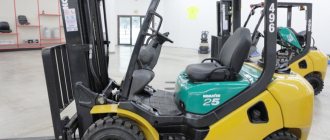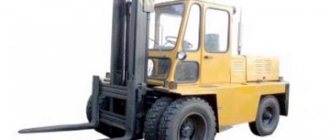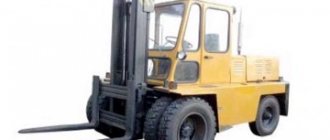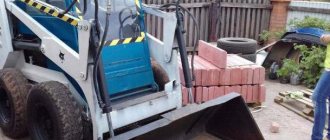Toyota produces many different modifications of forklifts. All of them can be divided not only by performance characteristics (overall dimensions, engine parameters), but also by the type of fuel used (gasoline or diesel).
Toyota forklifts are marked as follows:
- 7FD – diesel;
- 7FG - gasoline.
All forklifts from Toyota are two-axle. The following modifications exist:
- 7FG35;
- 7GD35;
- 7FG40;
- 7FD40;
- 7FG45;
- 7FG50.
The last two digits in the set of symbols indicating the model indicate the carrying capacity. Number 35 – 3.5 t, 40 – 4 t, 45 – 4.5 t, 50 – 5 t.
Among the wide variety of backpack sprayers, gasoline models are considered the most productive and reliable. And here you will find information that will help you make a swamp vehicle with your own hands.
Performance characteristics of Toyota forklift
All models have some differences from each other. But there are certain parameters that are the same for all modifications:
- the load is lifted to a height of up to 3,000 mm;
- wheelbase is 1,840 mm for the rear axle, 2,000 mm for the front axle;
- free lift value – 110 mm, 115 mm, 120 mm;
- The center of gravity of the load is 600 mm.
The dimensions of the equipment differ depending on the specific model - this must be taken into account when it is necessary to purchase spare parts for Toyota forklifts. Those that are capable of handling a load weighing 3.5 tons have the following dimensions:
- 2,140 mm – height including roof;
- 1,350 mm – width at the center of the body;
- 2,925 mm – length from counterweight to forks.
Those intended for working with cargo weighing 4 tons have slightly larger dimensions:
- 3,065 mm – length from counterweight to forks;
- 1,450 mm – width at the center of the body;
- 2,235 mm – height including roof.
Models designed to handle 4.5t load:
- 3 130 mm – length from counterweight to forks;
- 1,450 mm – width at the center of the body;
- 2,235 mm – height including roof.
The five-ton loader has the following dimensions:
- 3 170 mm – length from counterweight to forks;
- 1,450 mm – width at the center of the body;
- 2,235 mm – height including roof.
The speed parameters for all models are approximately the same: the normal speed is approximately 23.5-24.5 km/h, the maximum possible is 24-25 km/h. A very important advantage of the technology in question is its maneuverability.
Toyota forklifts can turn around virtually on the spot without any difficulty. The turning radius is 2,610 mm.
This loader can operate at fairly high speeds. Thus, the fork lifting speed with maximum load for all models is 511 mm/s, without any load – 551 mm/s.
Engine
Toyota products can be equipped with various units - gasoline and diesel. Petrol is marked 1FZ-E, diesel – 15Z.
Their working volume is slightly different. Gasoline engine – 4,476 cc. cm, 5,204 cc cm - diesel.
Despite this difference in volumes in favor of the diesel engine, the unit running on regular gasoline has more power - 63 kW. While the diesel internal combustion engine is 55 l/s. The torque of the engines also varies:
- 294/1200 (Nm/rpm);
- 280/1800 (Nm/rpm).
A distinctive feature of the units under consideration is their extremely high environmental friendliness. The amount of harmful substances released into the atmosphere is reduced to a minimum.
In addition to the above engines, gas units are used in the design of the loader. They operate on liquefied gas – propane and butane.
3 ton forklifts
The Toyota brand has gained real recognition in the world market thanks to the introduction of advanced technologies in the production of warehouse equipment. Toyota forklifts have long been recognized as reliable equipment with excellent operational and comfortable capabilities. A large selection of loader models with different types of engines provide an excellent opportunity to choose the most suitable option that satisfies all customer requirements.
Loader models with a lifting capacity of 3 tons have excellent maneuverability and compact dimensions, designed for loading and unloading operations on open cargo areas and in closed warehouses. High performance of automobiles is ensured by reliable and powerful engines, high maneuverability of the wheelbase, stable and accurate operation of the braking mechanism.
Toyota diesel forklift 3 t
Works on most outdoor production sites. The engines are characterized by low fuel consumption, low noise and vibration levels, and exhaust gas emissions are neutralized by effective filters. He is not afraid of working in low temperature conditions.
Toyota gasoline forklift 3 t
Used outdoors and indoors. Compared to a diesel car, it has more environmentally friendly characteristics in terms of the quantity and content of exhaust gases, as well as a lower noise level. The simple design of the engine allows you to avoid investing large amounts of money on its maintenance.
Toyota gas-gasoline loader 3 t
Can run on gas or gas-gasoline fuel. Good filtration of harmful exhausts allows productive use of this type of equipment in closed warehouses with good ventilation. Not afraid of frosts down to -5 °C and high humidity conditions. Lower noise levels compared to diesel forklifts provide a favorable working environment for the operator. Clean fuel combustion does not require frequent oil changes, which increases the service life of the units.
Toyota electric forklift 3t
The most environmentally friendly type of forklift, powered by traction batteries. Used in closed spaces of warehouses, wagons, containers. The active stabilization system ensures good stability of the equipment, synchronization of the steering and control of the mast. Convenient and easy to maintain.
Comfort of use
A Toyota forklift is extremely comfortable to use thanks to a special seat with lateral support. It makes it possible to sit in the driver’s seat with great comfort and even on sharp turns without experiencing discomfort, making an effort to hold on.
The height of the driver's seat is also easily adjustable thanks to its design. It is located on a special telescopic stand, which can be adjusted using a special lever.
All controls are located close to the driver, there is no need to reach very far in order to carry out any manipulations with the loader. The right armrest is a five-lever control panel.
It is with its help that all necessary loading and unloading operations are carried out. The steering wheel is small, which does not make driving any less comfortable: to turn it is enough to tilt the steering wheel only a little, the hydraulic booster will do the rest.
There is a special flywheel on the steering wheel, which allows you to control the movement of the loader with just one hand. This is very convenient if you need to simultaneously move and load and unload.
Attention! This equipment is equipped with two headlights. One of them shines forward, illuminating the cargo and the space ahead. The second light makes everything behind the forklift easily visible thanks to the powerful light output halogen bulb.
Toyota loaders are especially comfortable for the following reasons:
- the presence of a wide corrugated footrest , which allows you to comfortably get on and off the lift;
- The equipment is equipped with the SAS system (automatic steering synchronization);
- extremely large amount of free space above your head . This is what allows the driver to take the most comfortable position, regardless of his height;
- There is a special niche in which you can comfortably place your feet .
Toyota loaders: model characteristics
The world-famous company has also been producing equipment such as forklifts for many years; quite a few fork models have already been presented. Each differs in the engine used, fuel type, size and other properties. Gasoline versions are presented with the designation 7FG, diesel forklifts are called 7FD. Regardless of the version, loaders are created on two axles, and the load capacity can be found out from the name of the modification. A loader with a lifting capacity of 1.5 and 5 tons is considered very popular, where the first can be used for transporting small loads in warehouses, and the second is excellent for use in ports and factories.
Regardless of the model, Toyota loaders are of high quality and reliability, but each loader also has the same characteristics:
- maximum lifting height - 3000 mm;
- wheelbase is 1,840 mm at the rear, 2,000 mm at the front axle;
- center of gravity indicator within 600 mm;
- the maximum possible speed varies between 24-25 km/h.
The design of this equipment is unique in that the loader is able to turn around almost on the spot; the specified turning radius was 2,610 mm. It maneuvers well when in motion, making it ideal for use in small objects when it is necessary to transport heavy loads.
It is impossible not to highlight the excellent speed of work; a loader will only need 511 mm/s to lift the forks with a maximum load; if the forks are unloaded, the lifting speed increases to 551 mm/s.
Toyota 1.5 t diesel loader: characteristics
The least powerful model in the manufacturer’s range is considered to be a loader with a lifting capacity of 1.5 tons. The model is called Toyota 02-8 FGF15, officially presented as a counterbalanced gas forklift. With a carrying capacity of 1.5 tons, the equipment received a final weight of 2,450 kg; it is based on a 4-cylinder diesel engine with a volume of 2.2 liters. This provides good traction, because the motor produces 38 kW of power. This is achieved by rotating at speeds up to 2,570 rpm.
The above results allow the loader to move at a maximum speed of 19 km/h. The equipment can also be called compact, the length was 3.29 meters, width 1.07 meters, loader height 2.08 meters. In contrast to the general characteristics above, the center of gravity of the FGF15 model was 500 mm (versus 600 mm for models from 3 to 5 tons). The equipment is also capable of lifting loads to a height of 2,960 mm, which is quite a good indicator.
The loader is ideal for working mainly outdoors, because the harmful waste generated will not allow long-term operation in enclosed spaces. With a Toyota 1.5 t loader, it is ideal to load and unload goods, stack them, and transport goods in a horizontal position.
Comfort of Toyota forklifts
An important indicator for the Toyota 1.5 t diesel forklift and other models is comfort during operation. This indicator is at a high level, which confirms the presence of a comfortable seat with lateral support. Thanks to this, you can feel comfortable even during maneuverable turns and high speeds.
If desired, the height of the driver's seat is adjustable; to control all the buttons and operating parts, they are located close to the driver, so there is no need to reach anywhere. For easier control, a special flywheel is installed on the steering wheel.
Video
Features of the technology in question
Toyota loaders are equipped with a patented active stabilization system, which gives the equipment excellent stability.
Even in the most extreme operating mode, on bumpy, uneven surfaces, each wheel is automatically set in a position that provides it with maximum support.
A special microcontroller controls the operation of the shock absorbers. It engages the locking of the axle(s) at the right moment. This also gives the equipment additional stability, which allows loading without much difficulty.
The fork level is also controlled by a special device, which allows you to perform even complex loading operations with minimal difficulty, without the risk of dropping or damaging anything.
The loader mast is constantly in one position. It is equipped with a specially designed mechanism with a built-in stabilization system.
Controlling the equipment in question is extremely simple and not difficult due to the efficiency of the device responsible for synchronization. It makes it possible to automatically change the position of the rear axle and steering wheel.
In addition to all of the above, this special equipment is equipped with:
- power steering;
- lifting mast with a wide viewing angle;
- safe fork lowering system;
- a device that blocks accidental startup;
- roof with seamless structure;
- multifunction display.
The multifunction display makes the truck especially easy to use. The load weight indicator is displayed on it. This indicator allows you not to exceed the maximum permissible load for which this equipment is designed.
The multifunction display also provides a wealth of other information, such as the speed of the forklift. If the maximum permissible value is exceeded, a special speaker emits a warning beep.
The tire tread makes it easy to move even through mud, as its thickness is quite large. The tread lines are located in such a way that the wheels easily cling even to very liquid soil.
Gas VS electric: comparison of Toyota forklifts
Choosing the right forklift is one of the most important aspects of optimizing warehouse operations. After all, when warehouse equipment effectively copes with the assigned tasks, your business also runs like clockwork - without downtime and loss of profit. Most often, doubts arise when choosing between gas and electric forklifts. They are quieter and more environmentally friendly than diesel models, but they have several significant differences:
- Changing a gas cylinder is easier than replacing a battery, but one battery is sufficient for most double-shift workloads.
- Buying an electric forklift will cost more than gas-powered equipment, but the overall cost of ownership is lower.
So which type of forklift should you choose? Let's try to figure out in what cases it is better to use each of them.
When should you use an electric forklift?
First, let's look at the pros and cons of an electric forklift. This technique is definitely your choice if:
- Reloading work is mainly carried out indoors.
- Requires maintaining a sterile environment (moving pharmaceuticals, food, etc.).
- The storage area is not well ventilated.
Let us also highlight such advantages of electric forklifts as quiet operation and ease of maintenance due to a minimum of moving parts. Also, you will not need to allocate a special place in the warehouse for storing potentially hazardous fuel.
Restrictions on the use of electric forklifts
Despite all the advantages, it is not rational to use an electric forklift when:
- Reloading operations are carried out mainly in open areas.
- The air temperature in the warehouse drops below +10℃ (this reduces the battery capacity of the forklift).
- It is not possible to organize a separate room for charging batteries.
- The work is carried out in several shifts, so replacing batteries will take up valuable time. Note that the energy efficiency indicators of Toyota equipment are among the best in the world, so 1 battery charge is enough for 9 hours of operation.
- The floor in the warehouse is uneven, or gravel is used as a covering.
Also, purchasing an electric forklift will cost more than a gas-powered model. Although, within a couple of years, you will fully recoup your costs as electric forklifts have the lowest cost of ownership compared to other types of forklifts.
In what cases should you choose a Toyota gas forklift?
Customers often ask us the question: can gas forklifts be used indoors? After all, during their operation, much less exhaust is released than during operation of a diesel engine.
The answer is yes, but for a short period of time. And provided that the warehouse has a powerful ventilation system, of course! So if your loader will work outside most of the time, sometimes driving inside the warehouse, a gas-gasoline model will be a good choice.
The features of gas forklifts make their purchase optimal when:
- Reloading work is mainly carried out on the street.
- There is a need to work at low air temperatures.
- The surface of a warehouse or open area is uneven; equipment will move on gravel or soil.
There are other advantages of gas forklifts: for example, replacing a propane tank takes less time than charging a battery, and engine power does not decrease throughout the entire work shift.
Are there any restrictions on the operation of gas-gasoline forklifts?
Equipment with a gas engine is definitely not your choice if:
- It is necessary to move medicines, food and other goods that require maintaining a sterile environment.
- The forklift will work primarily inside the warehouse.
Don't forget that fuel costs can fluctuate depending on price changes. Therefore, you should not buy a gas forklift solely in an attempt to save money: yes, its price is lower than that of an electric one, but gas is more expensive than electricity, and the engine requires periodic maintenance.
As you can see, each of the loaders has its own characteristics, and it is impossible to give a definite answer to the question - which one is better? Always select a forklift based on the conditions of your warehouse, as well as the tasks assigned to the warehouse equipment.
One thing is for sure - regardless of the engine type, all Toyota loaders are durable and of true Japanese quality. After just a few years, the seemingly expensive purchase will fully pay for itself due to the absence of breakdowns leading to downtime in the warehouse. You can select a suitable forklift model in our catalog, or by calling the sales department. Our managers are always ready to advise you and help you choose Toyota warehouse equipment.
Select a loader
